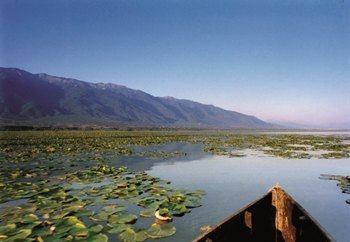Primary outflows Strymon River Max. length 17 kilometers (11 mi) Area 110 km² Length 17 km Outflow location Struma | Primary inflows Max. width 5 kilometers (3.1 mi) Surface elevation 35 m Width 5 km Inflow source Struma | |
 | ||
Similar Vrontous, Sarakatsani Folklore Museum, Gazoros, Fort Roupel, Lake Plastiras | ||
Lake Kerkini (Greek: Λίμνη Κερκίνη), is an artificial reservoir that was created in 1932, and then redeveloped in 1980, on the site of what was previously an extremely extensive marshland.
Map of Lake Kerkini, Kerkini 620 55, Greece
Before 1932, there were irregular marsh lakes on Strymon, one of them called "Podkova" Ottoman Turkish: ݒودقوه كولي Podkova Gölü became the mother of Kerkini.
Lake Kerkini is now one of, if not the, premier birding site in Greece, and, as it is situated along the migratory flyway for migratory birds en route to the Aegean Sea, the Balkan region, the Black Sea, the Hungarian steppes and beyond it experiences an interesting migration.
In the flat and semi-mountainous area, important hydrobiospheres are developing which are of great international significance and acceptance. The most essential hydrobiosphere is the one in Kerkini lake. It is a miracle of nature which came about by man's technical intervention on the natural characteristics of Strymon river. The water extent, which varies from time to time from 54 Km2 to 72 Km2, works out to be useful in two ways: as a technical work of great agricultural utility and as a hydrobiosphere for thousands of water fowls.
This wonderful biosphere is recouped by the International Convention of Ramsar and presents numerous admirable elements. Thousands of birds, both rare and protected, riverside forests, water-lilies in a large area, fish variety and fantastic panoramic view from the mountains of Belasica and Krousia give it a characteristic tone. Actually the lake hosts 227 kinds of birds, especially non-migrants. 76 of them are recorded in the National Red Catalogue, while at least 31 of them are protected by EEC's Directive concerning wild life. What makes an exceptional presence is the buffalo's herd in the area, plus the one of the jackelo in the area of Kerkini lake. In the surrounding area of Kerkini lake there are at least 10 amphibian species (frogs, salamanders, tritons), five snail species, 19 reptile species (lizards, snakes, turtles) and a great variety of insects which play an important part in the food chain and contribute towards the biological resources of the lake.
A winter view of some tree at Kerkini lake The lake was created where Kerkini lake was by making embankments on the eastern and western sides and a dam was constructed near the village of Lithotopos, which started functioning in 1932. The main water provider of the lake is Struma River. Additionally, there is Kerkinitis river from Krousia that flows into the lake. After the construction of the dam, the form of the initial hydrobioshere changed completely. The human intervention usually retracts or takes negative action against the natural processes, Kerkini lake is a rare example, where the gentle human handling had the exact opposite result.
As time went by, the lake's capacity was reduced because of the substances that were washed up by Strymon river. So the rising of the embankments and the construction of a new dam was necessary, which was started operating in 1982.
Its natural beauty, its high ecological significance and its contribution to the agricultural production of the valley of Serres, act as a main promoter of well-being and development. It is worth visiting as well as making any possible effort to preserve its wealth.
